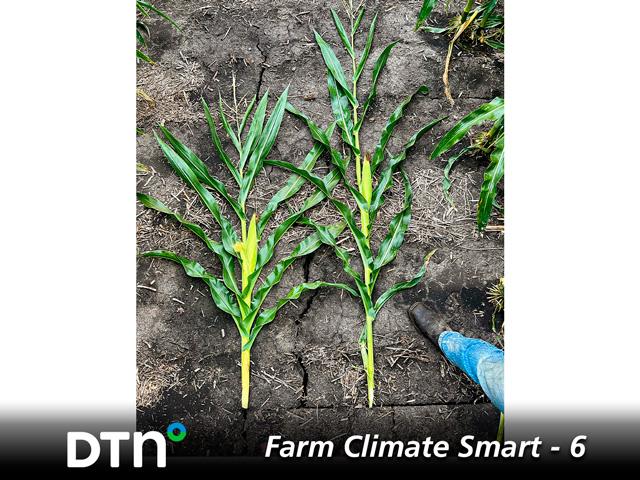Farm Climate Smart - 6
New Corn Technologies to Withstand Variable Environments
The roiling wind that blew through a Bayer weed-control research plot in western Illinois this past summer made a short-stature corn believer out of Dave Shenaut.
"There were pockets of the traditional corn that were 70% lodged or green snapped during that event. The short-stature corn had 5% or less injury," said Shenaut, a Bayer technology development representative. "Simple physics should indicate it would do better in these kinds of winds, but when viewed from air by drone, the difference was dramatic."
Compared to traditional hybrids, short-statured plants stand about one-third shorter with a lower ear set at least 24 inches above the soil surface. Several seed companies have the concept in development pipelines.
Reduced-stature corn mostly began to increase population density and simplify over-the-top application of inputs. But extreme weather events now have seed companies shining a resiliency spotlight on the system. "One thing we are seeing is the roots of these new shorter hybrids tend to explore more soil faster," Shenaut noted.
DTN/Progressive Farmer is continuing its special series of articles called Farm Climate Smart that examine what the term means, looks at current and future economic opportunities the movement offers for farmers and ranchers, and highlights what some producers are doing now to make their land and crops more resilient to a changing climate. In today's article, the sixth in the series, DTN looks at how companies are eyeing new technologies to help corn withstand variable environments.
SIP DON'T SLURP
When it comes to weatherproofing corn, seed companies have long concentrated research and development on identifying native genetics that allow hybrids to convert water more efficiently and better tolerate drought. Farmers have access to those products through market names such as DroughtGard (Bayer), Optimum AQUAmax (Corteva) and Agrisure Artesian (Syngenta).
Tom Greene, Corteva Agriscience biotechnology leader, expects breeding efforts with native traits to continue to be important. But he sees new genetic tools allowing scientists to deliver even more stress tolerance and yield stability in the future.
"We have a yield stability trait that is working through our pipeline today that is very complementary to what we've done with AQUAmax," Greene said. This gene will promote small yield advantages in normal environments but provide a bigger advantage under environmentally challenged environments.
"We basically take a corn gene and modulate its transcription factor," he explained. Transcription is the process of copying a segment of DNA into RNA. Think of it as giving the plant instructions to endure a particular stressor.
"By extending and elevating expression just a bit, we see improvements in several agronomic attributes. "Photosynthetic capacity is up a bit. Leaf area index is up a little bit. We see improvements in nitrogen uptake and assimilation -- a lot of agronomic properties that lead to overall stability across environments," Greene said of the yield stability trait, estimated for launch early in the next decade.
P[L1] D[0x0] M[300x250] OOP[F] ADUNIT[] T[]
ROOTS THAT REACH
Greene pointed to the already large gap between average national yields and genetic potential of corn. "Heap climatic challenges upon that, and it's a daunting task to stay ahead," he noted. He believes it will take combinations of approaches to weather climate changes.
Corteva is developing short-statured hybrids with this in mind, as well. "There's no doubt we're seeing enhanced stability and better stalk strength, which leads to more yield in those years where wind events play a factor," Greene said.
At a Bayer field day this fall, Kelly Gillespie, vice president of Digital Ecosystem Services, noted the root structure of short-statured corn in what Bayer will call the Smart Corn System upon commercialization. "We are seeing differences in how tap roots and secondary corn roots explore the soil," she said.
Whether this root race leads to increased water and nutrient uptake to better withstand variable environments is still on trial. "But we've measured the ability of these roots to grow deeper and faster many times," Gillespie added.
Shenaut is excited about the possibility of increasing plant populations without a reduction in standability. "All of this makes sense if you think about how the corn plant stores carbohydrates," he observed.
"A tall plant sends a lot of those carbohydrates to the internodes. In the case of short-statured corn, they aren't allowed to continue to extend, so the excess carbohydrates could or may be sent to the root system," he said. "We're still working to understand it all, but water and fertility benefits to the system are exciting."
**
This is the sixth story in DTN/Progressive Farmer's Farm Climate Smart series.
To see Farm Climate Smart - 1: https://www.dtnpf.com/…
To see Farm Climate Smart - 2:
To see Farm Climate Smart - 3:
To see Farm Climate Smart - 4:
To see Farm Climate Smart - 5:
To see a related blog, go to https://www.dtnpf.com/…
You can also hear a podcast about the series at https://www.dtnpf.com/… -- go to Field Post E124: Get Smart on Climate Smart.
Pamela Smith can be reached at Pamela.smith@dtn.com
Follow her on Twitter @PamSmithDTN
(c) Copyright 2022 DTN, LLC. All rights reserved.






